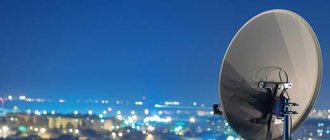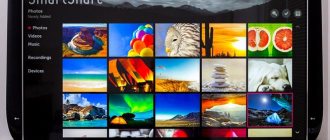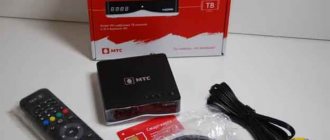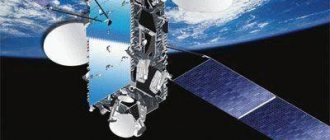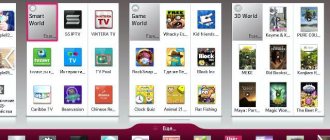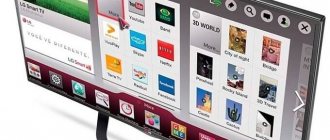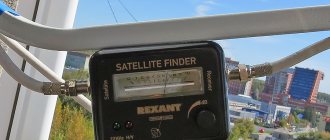Using a satellite dish makes it possible to watch many interesting programs.
In order to ensure a good signal, you need to fine-tune your satellite dish.
An error of even a few degrees can result in signal loss. In order to carry out such adjustments, special programs are used. SatFinder is one of the highest quality applications used for setting up satellite dishes.
SatFinder program interface
What kind of application is this, what is special about satellite finder?
You can set up the satellite dish yourself. To do this, you need to know how to do this and have all the necessary information about the satellite that transmits the signal. Knowing the exact direction based on his coordinates, the user has the opportunity to properly tune the antenna.
The SatFinder application allows you to do the following:
- Sat Finder contains a list of all available satellites with basic data about them.
- By choosing the appropriate one, you can find out the exact azimuth and determine their height and the required tilt of the converter.
- For each satellite you can get a list of available channels.
- Satellite data can not only be presented digitally, but also reflected on maps
- If your smartphone has a built-in compass, this will help you directly determine the direction.
- The principle of augmented reality is used here. By viewing through the video camera, you can see the direction to the selected satellite.
The user can tune in to free channels of any of the available satellites that produce satellite broadcasting. Typically, the subscriber enters into an agreement with the provider and gets access to paid channels. After depositing money, he gets access to view them. In the latter case, he knows exactly from which satellite the broadcast is being made.
SatFinder users can take advantage of the following advantages:
- The program is distributed free of charge.
- Provides high accuracy in determining the azimuth and inclination angle of the direction to the satellite.
- At any time during work, you can take a screenshot, recording the received data.
- Simplicity and thoughtfulness of the interface. Even those who have been using it for a short time can easily learn how to use this application.
- Low consumption of system resources.
- High speed.
SatFinder is one of the most popular offerings for determining the coordinates of broadcast satellites.
Devices with digital LCD display and battery
The cost of such devices varies from 2 to 3 thousand rubles. They have an LCD display and, very importantly, a built-in battery. This makes the device more mobile and allows you to use it regardless of the receiver. As a rule, such devices already have preset parameters for popular satellites and their transponders. The disadvantages of such a satellite finder include a small screen for reading parameters, a limited number of buttons, which makes entering parameters longer and more inconvenient. The SF-600 is an example of such a device.
Where to download and how to download the satfinder application
The SatFinder application can be downloaded and installed on an Android smartphone. It is available at https://play.google.com/store/apps/details?id=com.esys.satfinder.
To do this, you need to open the specified address from your smartphone and click on the “Install” button on the page. After this, the application will be downloaded and installed automatically.
If for some reason Google Play is not available at this moment, you can use a search engine, for example, Yandex, to search for the program. For example, if you enter the text “SatFinder for a smartphone with Android”, then in the search results you can find pages from which you can download the application.
How to use satellite finder on your phone to set up satellite dishes
Before starting work, you need to make settings. The following points will need to be adjusted:
- Audio Alert – allows you to enable or disable the sound signal when determining the correct direction to the satellite.
- The search for the desired direction will be carried out with a certain accuracy. It can be set in this settings item. If it is too high, you will have to spend considerable effort determining the exact direction. If insufficient, it will affect the quality of the received signal.
- Satellite List section will provide a list of those satellites with which you will work. This application works with almost all TV broadcast satellites in the world. It should be borne in mind that only part of them is needed. Here you can make a short list of satellites that will be displayed in the program. If necessary, it can be supplemented or reduced.
Satellite List
When you first launch the program, it will ask for permission to use GPS. If this is not done, SatFinder will not be able to perform its functions.
SatFinder requests permission to use GPS
To use the Satfinder satellite search program, you need to do the following:
- You need to turn on the Internet and keep in mind that it is not always possible to access GPS while inside buildings. It is advisable to make the adjustment outdoors or while being near a window . In some cases, determining the user's location may be slow. If this happens, you need to wait until it is done.
- The next step should be to specify the desired satellite . To do this, you need to get the names of those that are above the horizon. To do this, you need to click on the icon with the image of a magnifying glass. You will need to select the desired satellite from the list provided. List of satellites in satellite finder
- Next, the necessary calculations are carried out and the user is provided with the azimuth, altitude and inclination angle of the direction to the satellite . When determining azimuth, magnetic inclination is taken into account. In this case, the green line will be directed towards the satellite, and the red line will show the direction of the smartphone at that moment. The user must reposition the phone so that these two lines match.
Azimuth, altitude and inclination angle of the direction to the satellite
To get an accurate value, you must first calibrate the built-in compass. To do this, after turning it on, you need to rotate the gadget several times relative to all three axes.
Next to the magnifying glass icon is an icon with a book symbol on it. If you click on it, a Google map will open, on which the user’s location will be marked.
When setting up, you can use two search methods: arc display and precise position detection.
In the first case, viewing is done through a video camera. The image shows the following data:
- A visual arc (also called the Clark Belt) on which all available satellites are located in various locations.
Clark Belt - There is an exact direction mark to the selected satellite.
- At the bottom of the screen, precise data characterizing the direction to the satellite is indicated in digital form. They occupy two lines.
This method allows you to visually determine the direction to the broadcast satellite. At the same time, you can see whether there are any obstacles to signal reception. If necessary, you can take a screenshot to capture the information shown here.
To determine the direction, you can use the precise detection mode. At the same time, an image resembling a sight is shown on the screen.
In the center the satellite's elevation angle and the azimuth of the direction towards it are indicated. Yellow arrows may be shown on four sides. They appear in cases where the position of the phone needs to be adjusted in the appropriate direction.
Once the correct direction is established, the arrows will turn green, point to the center of the screen, and a beep will sound.
Review of the Sat finder Android application for setting up satellite TV:
Bluetooth devices
The cost of these devices ranges from 2 to 3 thousand rubles. These are satellite devices that do not have buttons or screens. Essentially, it's just a plastic box with inputs for an antenna and external power. These devices are very compact. They are full-fledged satellite signal receivers and transmit all readings to the application user interface on a mobile gadget via Bluetooth. These devices allow you to turn your smartphone or tablet into a tool for setting up satellite dishes. The device is controlled using a free mobile application, which is available for Android and iOS. As a rule, all satellites and their transponders are already entered in the application. You configure the satellite dish by looking at the smartphone screen.
Like other devices, Bluetooth meters are not without their drawbacks. These include the lack of a battery and the need to use external devices for power. Such devices include, for example, V8 Finder and Hellobox.
Bluetooth device V8 Finder
How to set up satellite TV using the SatFinder device
In order to begin the installation procedure, you can use a specialized measuring device. The built-in capabilities of the TV or tuner may not be enough to carry out this work.
This device is called SatFinder. Its name reflects its purpose - searching for a satellite, determining the optimal parameters for receiving a signal.
SatFinder device
This device has two connectors. One of them is intended for connecting a satellite dish (labeled TO LNB), the other (TO REC) is used to connect the cable from the tuner. When the device is not in use, there are plugs on the connectors.
There is an adjustment knob that can be rotated left or right. The scale has numbers from 0 to 10. There is an arrow, which, when fine-tuned, should show the highest possible number.
In order to configure, you need to connect an antenna and tuner to the device. Tuning consists of changing the direction of the antenna in search of the optimal position. When a signal appears, the device starts beeping. The louder the device beeps, the more accurate the setting is.
Next, you can use the adjustment knob to improve the signal. By tightening it, you can make more precise adjustment to the satellite signal.
After the correct direction has been found, you need to fix the position of the antenna. The receiver is then directly connected to the satellite dish.
How to set up a satellite dish with your own hands using the SatFinder device:
It is important to know
The signal from the broadcaster is sent to the user through a transceiver device - a repeater. To receive the image, a receiving device is used - a satellite dish. Terrestrial and satellite television operate on this principle, but in the latter case, instead of a tower, a satellite placed in geostationary orbit serves as a repeater.
All satellites are located on the equatorial plane and at a specific longitude, to which the antenna is directed. Subsequently, the set-top box is configured to search and display the channels broadcast by a specific satellite.
Problems and their solutions
On phones with a weak video camera, the data will be poorly visible if you work during the day in bright sunlight. In this case, it is better to carry out setup work in the morning or evening.
If you set the adjustment accuracy parameter to a high level, it may be disrupted due to measurement error. The accuracy must be such that it ensures high signal quality. If you increase it too much, it will not improve it, but will only complicate the adjustment.
Sometimes it is necessary to determine the correct direction of a satellite dish in a location other than where the user is located. The program provides this opportunity. To do this, you need to activate the corresponding item in the settings.
While the program is running, you need to view advertisements. This can be disabled if you purchase the paid version. There are no other differences between these options. The free version is fully functional.
Self-Configuration Issues
The goal in this case is the same as when connecting a conventional VHF/UHF antenna - you need to install the receiving device so as to pick up a signal of an acceptable level.
Unlike conventional TVs and set-top boxes, the satellite receiver monitors the received and recorded signal:
- Red stripe. Shows the level of radiation from the satellite falling on the receiving device.
- Yellow stripe. The quality of the signal received by the receiver.
The second signal level (recorded on the receiver) is needed because it displays the image on the TV. Its power is always lower than the incident radiation on the convector, because The cable is relatively noisy.
The longer the cable, the lower the power of the radiation recorded at the receiver will be, which will require more precise direction to obtain an acceptable level of radiation at the output. It is recommended to minimize the distance from the convector to the set-top box if possible.
It is necessary to adjust the antenna (dish with a convector installed) so that the value of the yellow stripe is not lower than 65%.
Before tuning, the head is fixed to the convector in the middle or offset downward (if an offset reflector is included), and an antenna cable is connected to it from the receiver. Next, you need to connect the set-top box to the TV and switch it to the physical channel corresponding to the connection connector.
As a result, the screen should display the physical channel number of the set-top box and two indicated bars with the signal level value.


